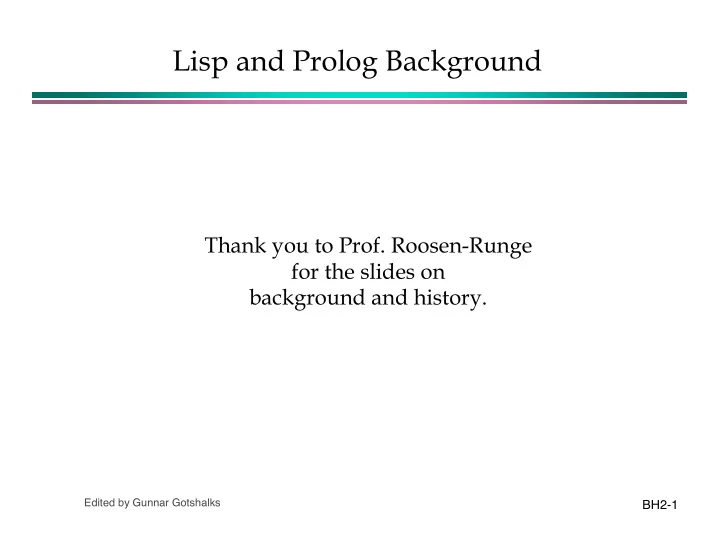

Lisp and Prolog Background Thank you to Prof. Roosen-Runge for the slides on background and history. Edited by Gunnar Gotshalks BH2-1
Lisp History • Lisp--invented ( about 1958 ) by the logician and AI researcher John McCarthy • Widely used in for applications in AI every since • Used in industry » To develop expert systems & other AI applications » For Rapid Application Development (RAD) Edited by Gunnar Gotshalks BH2-2
Lisp Use • Lisp is used as an embedded language • Found inside applications like Emacs (MLisp) and AutoCAD (AutoLisp). » Emacs supports Lisp as a language for developing programs » As well as embedded language for controlling and customizing the editor itself Edited by Gunnar Gotshalks BH2-3
Lisp availability • On all major and many minor platforms. • Numerous free- and shareware versions. • Standard: Common Lisp Edited by Gunnar Gotshalks BH2-4
Prolog history • Prolog invented ( ≈ 1972) » Used at York in the by the AI researcher Student Information System to check Alan Colmeraurer applications for input errors • Widely used to develop » Early ideas developed expert systems & other at University of Montreal; then AI applications including University of natural language Marseilles processing Edited by Gunnar Gotshalks BH2-5
Prolog Use & Availability • Prolog rumored to be embedded in MS Office • On all major and many minor platforms • Several free and shareware versions • Standard: ‘ Edinburgh-style ’ Edited by Gunnar Gotshalks BH2-6
Survival Value McCarthy's Lisp versus Newell's IPL (Information Processing Language) » Both proposed » Both men pioneers languages at about the in AI and computer same time for symbolic science computing to be used in AI research Edited by Gunnar Gotshalks BH2-7
And the winner is ? McCarthy? Newell? Why? Edited by Gunnar Gotshalks BH2-8
& the winner is ... • Value of ‘ high-level ’ over ‘ low-level ’ language wasn ’ t so clearly recognized in the early days. • Newell made what turned out to be a fatal error for his language → This made his language very ⇒ Newell modeled IPL operational on the assembler → Couldn't be understood in language for an mathematical terms. early computer instead of timeless → Wasn't accepted as a notation for AI programs. logic Edited by Gunnar Gotshalks BH2-9
Low- and High-level – 1 • Lisp became the ‘ assembler language ’ – lower-level – for AI programmers » Used to build higher-level systems » Wilensky Chapters 21 & 22 give the basis for Prolog! • Common Lisp = union of the techniques and tools people have found useful. Edited by Gunnar Gotshalks BH2-10
Low- and High-level – 2 Prolog is a higher-level language for knowledge-based programming » More powerful, not necessarily as efficient » More compact » More understandable programs. Edited by Gunnar Gotshalks BH2-11
Pure Lisp • Denotational, functional rather than operational » No states: just a mapping between arguments and result or, from input to output. • ‘ Pure ’ Lisp is all we will have time to discuss in this course » It's what makes Lisp distinctive Edited by Gunnar Gotshalks BH2-12
Pure Prolog • ‘ Pure ’ Prolog: denotational & declarative • Just 1 state » A ‘ knowledge ’ base = database for facts • This turned out to be a very big advance! Edited by Gunnar Gotshalks BH2-13
Lisp vs. Prolog ? Which AI language an AI researcher uses often depends on where they studied. • At Edinburgh, almost • At MIT and Stanford, all Prolog almost all Lisp • MIT has used a dialect of Lisp called Scheme in their first year programming course for many years. Edited by Gunnar Gotshalks BH2-14
At York • We have been more a ‘ Prolog shop ’ than a ‘ Lisp shop ’ in this department. • Prof. Stachniak teaches a 4th year course on Logic Programming which includes a more advanced look at Prolog. Edited by Gunnar Gotshalks BH2-15
Other Choices • There are many denotational, functional languages other than Lisp » ML is popular in British and some European universities – American universities tend to use Lisp • No strong competitors to Prolog at present, mainly variants, extensions, and dialects. • Objected-oriented add-ons available for both languages Edited by Gunnar Gotshalks BH2-16
Lisp in ‘ Production ’ Work • Programmers tend to use operational features – This is not good; it is the fault of poor software- development tools – There are claims that 90% of function calls in Lisp programs are to assignment functions – like setq and rplaca! • Assignment changes state and is sure sign of an operational description – Compare the palindrome programs Edited by Gunnar Gotshalks BH2-17
Recommend
More recommend